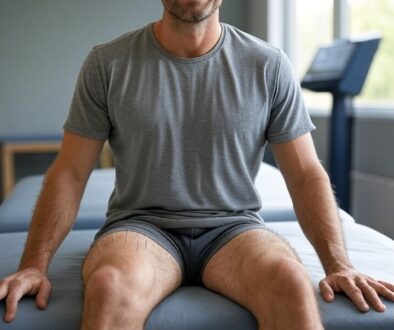The Dreaded POP – Pelvic Organ Prolapse
The Dreaded POP: Pelvic Organ Prolapse
Dr. Hannah Williams, PT
Pelvic Health Specialist
Pelvic organ prolapse may be more common than you think. Prolapse affects 1 in 4 women in their 40s, 1 in 3 in their 60s, and 1 in 2 by their 80s.1 Though it is more common in women, men also suffer from rectum or bladder prolapse.
Wondering if this is something you’ve struggled with?
-
Feel heaviness, pressure, or like something may fall out “down there”?
-
Avoid certain exercises or activities that might cause an accidental leak?
-
Feel self-conscious and less interested in intimacy?
Unfortunately, the medical community often dismisses the issue of prolapse, defining it a normal factor of aging or life after giving birth. Because of this, now multimillion-dollar companies (ahem Depends and Poise) built an industry capitalizing on the management of bladder-related issues. Perhaps the problem is that we’re managing instead of solving.
Let’s get something straight, there is NO shame in these products. They serve a valuable purpose when needed and are often used in the interim as symptom management. But they remain a bandaid and the bandaid isn’t healing the cut — your body is. When our bodies don’t know how to heal or can’t heal properly on their own, then our symptoms say the same, or get worse. What if you never had to buy products that only manage the issue and instead focused on your pelvic floor’s ability to heal and regain strength and muscle control?
Sound good? Then before we dive in, let me introduce myself! I’m Dr. Hannah, Physical Therapist at Peak Health and Performance. I specialize in post-operative, sports, tactical, and pelvic health rehabilitation and training. I am certified in trigger point dry needling and Neufit ESTIM, both of which are profound tools on the road to recovery and enhancing performance. Both dry needling and direct current electrical stimulation are excellent at providing immediate relief for muscle and joint pain as well as restoring functional movement and control. Now, let’s get down to the basics of POP.
A pelvic organ prolapse (POP) is when one of your pelvic organs slips out of position and bulges out.2 There are three types of prolapse which are defined by the organ that is slipping. You can experience prolapse with your bladder, uterus, or rectum, males of course, lacking the uterus. Additionally, prolapses have grades of severity ranging from 1 to 4. There are many factors that can increase risk of organ prolapse. Most common causes include:
-
Pregnancy and Childbirth
-
Aging and menopause
-
Hysterectomy surgery
-
Long-term constipation
-
Chronic cough
-
Obesity
-
Frequent heavy lifting with poor body mechanics
Many describe prolapse as a pressure or heaviness in the lower abdomen and perineal area. Patients may feel or see a slight bulge in or protruding from the vagina or between scrotum and rectum. Bladder functioning may decline, causing increased frequency, inability to fully empty, or leakage when sneezing or coughing. Unfortunately prolapse is widely misunderstood and often presumed as untreatable. Many women and men simply adapt their lives around the discomfort of prolapse or even the annoyance of bladder leakage. However there are certain misconceptions about prolapse that should be addressed, the first and most important being that it’s untreatable. POP is a fully treatable condition and Pelvic Floor PT is exactly where you should be! Other common misconceptions:
1. You can’t lift heavy things
Lifting heavy things is not a cause of prolapse. However poor body mechanics of tensing the pelvic floor muscles while exerting extreme effort creates pressure in the body and can worsen the prolapse. With the right mechanics and pressure management, you can lift safely and avoid pressure on your pelvic organs.
2. Pelvic Organ Prolapse is Painful
There is commonly sensation of discomfort and heaviness associated with prolapse, however pain is not normal. If you have pain, it is usually a hypertonic pelvic floor causing painful muscle tension and spasms.
3. Prolapse is Inevitable after Childbirth
Prolapse is very common immediately after giving birth, or even during pregnancy. However you can decrease your risk of prolapse with pelvic floor physical therapy. Much like training your muscles for a major physical event; preparing the pelvic floor for birth and recovery is just as important. Even with a diagnosis of prolapse postpartum, the grade and symptoms can still be changed.
4. You can’t have sex with Pelvic Prolapse
Pelvic prolapse does not prevent sex and it should not be painful. Remember pain with prolapse is not normal. With proper physical therapy treatment, you can continue to have a healthy, enjoyable sex life.
5. Surgery is the only answer
The grading/degree of pelvic prolapse determines the need for surgical management. Grades 1 and 2 pelvic prolapse can and should be rehabilitated without surgery. Grade 4 prolapses may require surgical intervention or the use of a pessary.
Our society is far too comfortable managing symptoms instead of teaching our bodies how to heal. But Peak Health and Performance is here to support you. Dr. Hannah is an expert in the field of pelvic floor health. She has rehabilitated her patients by providing exceptional, tailored treatments, support, knowledge, and tools to restore both your pelvic floor and quality of life. Prolapse is largely a pelvic floor function issue. I want you to return to daily activities and exercising in a safe way while preventing further injury. Body mechanics and breathing can significantly impact the abdominal pressure created in the pelvic floor. The goal is to reduce pressure on lower abdominal organs and pelvic floor. Remember, you want to use your body’s strength, especially with a prolapse: properly contracting abdominal walls, pelvic floor, glutes, and coordinating your breath to assist you. With pelvic floor physical therapy, you can help prevent prolapse, especially surrounding childbirth, and reverse the effects of prolapse long after it has occurred.
If pelvic floor prolapse symptoms have discouraged you, embarrassed you, or kept you from doing what you love. Don’t delay your healing any longer. We believe you’re worth it.
As always, our physical therapy clinic does participate in most insurance plans, including Tricare Select, Tricare Prime, and Tricare For Life for military active duty, military retirees, and their dependents. As military families ourselves, we at PHaP are excited to continue to serve our nation’s guardians and their families, and thankful to offer specialized services in orthopedics, post-operative, neurologic care, and pelvic health.
Resources
As always, our physical therapy clinic does participate in most insurance plans, including Tricare Select, Tricare Prime, and Tricare For Life for military active duty, military retirees, and their dependents. As military families ourselves, we at PHaP are excited to continue to serve our nation’s guardians and their families, and thankful to offer specialized services in orthopedics, post-operative, neurologic care, and pelvic health.
In health,
Dr. Hannah Williams, PT
Pelvic Health Specialist
Movement Specialist




